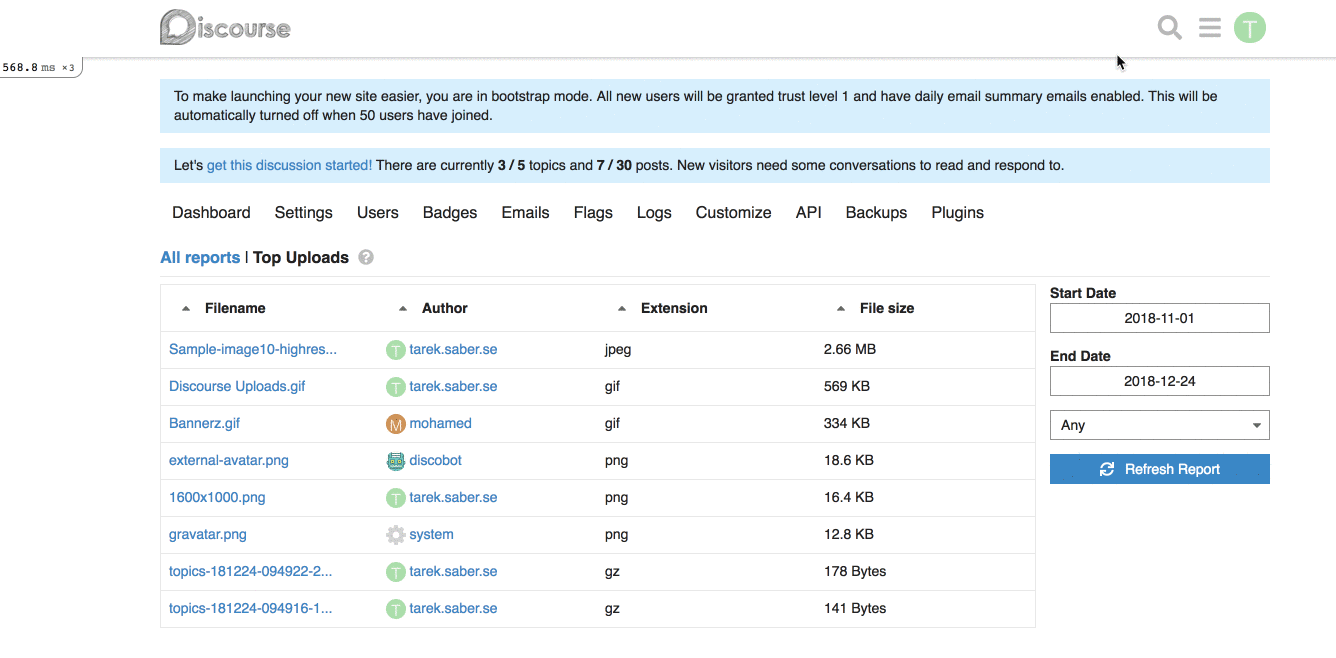This reverts commit d1c4981f65.
Per discussion with @coding-horror it was decided this change is to
far reaching.
Instead we will make smaller strategic changes to tooltips that add
value.
This will allow users installing a Discourse PWA to use their active
theme colors on the generated app. Thanks for @mgiuca for the tip.
Also makes the share_target config explicit to silence Chrome warnings
* improved emoji support
- always optimize images as part of the task
- use the unicode standard ordering/naming for sections
* UX: more height for when there are recently used
Migrates email user options to a new data structure, where `email_always`, `email_direct` and `email_private_messages` are replace by
* `email_messages_level`, with options: `always`, `only_when_away` and `never` (defaults to `always`)
* `email_level`, with options: `always`, `only_when_away` and `never` (defaults to `only_when_away`)
Previous instagram records didn’t have unique index, as a result it's seems like in some cases we have duplicate ids, which is causing issues with the associated_accounts which does have unique index.
It's sorted by `updated_at DESC` on the thought that the most recent one is more likely to be the one we want to keep.
This test did not support 'no auth' use case and other auth methods except 'login'. I fixed it by simply making the call to start() in the right way.
As shown in the source code of Net::SMTP (https://github.com/ruby/ruby/blob/ruby_2_5/lib/net/smtp.rb#L452), the start() function does accept the 'user' and 'secret' arguments. Also, in do_start() function (https://github.com/ruby/ruby/blob/ruby_2_5/lib/net/smtp.rb#L542), it automatically checks the auth method and args, skips the authentication if 'user' is not provided, and selects the right auth method from 'plain', 'login' or 'cram_md5'. This is exactly all of what we should do in a connection test and the odd 'auth_login' call in the previous code makes problems.
BTW, I am using 'localhost' as the third argument, which is the same as the default value in start(). This parameter is the domain address sent along with the 'ehlo' command in SMTP protocol. I have seen some documents, e.g. https://github.com/tpn/msmtp/blob/master/doc/msmtp.1#L455, saying that 'localhost' is fine. It works for me.
* FEATURE: Exposing a way to add a generic report filter
## Why do we need this change?
Part of the work discussed [here](https://meta.discourse.org/t/gain-understanding-of-file-uploads-usage/104994), and implemented a first spike [here](https://github.com/discourse/discourse/pull/6809), I am trying to expose a single generic filter selector per report.
## How does this work?
We basically expose a simple, single generic filter that is computed and displayed based on backend values passed into the report.
This would be a simple contract between the frontend and the backend.
**Backend changes:** we simply need to return a list of dropdown / select options, and enable the report's newly introduced `custom_filtering` property.
For example, for our [Top Uploads](https://github.com/discourse/discourse/pull/6809/files#diff-3f97cbb8726f3310e0b0c386dbe89e22R1423) report, it can look like this on the backend:
```ruby
report.custom_filtering = true
report.custom_filter_options = [{ id: "any", name: "Any" }, { id: "jpg", name: "JPEG" } ]
```
In our javascript report HTTP call, it will look like:
```js
{
"custom_filtering": true,
"custom_filter_options": [
{
"id": "any",
"name": "Any"
},
{
"id": "jpg",
"name": "JPG"
}
]
}
```
**Frontend changes:** We introduced a generic `filter` param and a `combo-box` which hooks up into the existing framework for fetching a report.
This works alright, with the limitation of being a single custom filter per report. If we wanted to add, for an instance a `filesize filter`, this will not work for us. _I went through with this approach because it is hard to predict and build abstractions for requirements or problems we don't have yet, or might not have._
## How does it look like?

## More on the bigger picture
The major concern here I have is the solution I introduced might serve the `think small` version of the reporting work, but I don't think it serves the `think big`, I will try to shed some light into why.
Within the current design, It is hard to maintain QueryParams for dynamically generated params (based on the idea of introducing more than one custom filter per report).
To allow ourselves to have more than one generic filter, we will need to:
a. Use the Route's model to retrieve the report's payload (we are now dependent on changes of the QueryParams via computed properties)
b. After retrieving the payload, we can use the `setupController` to define our dynamic QueryParams based on the custom filters definitions we received from the backend
c. Load a custom filter specific Ember component based on the definitions we received from the backend
* First take
* Add support for sprites in themes
Automatically register any custom icons added via themes or plugins
* Fix theme sprite caching
* Simplify test
* Update lib/svg_sprite/svg_sprite.rb
Co-Authored-By: pmusaraj <pmusaraj@gmail.com>
* Fix /svg-sprite/search request